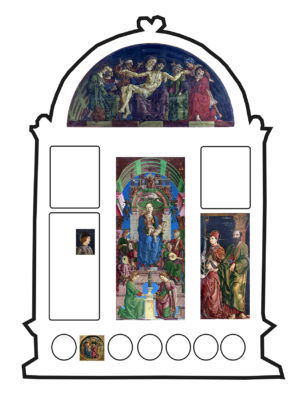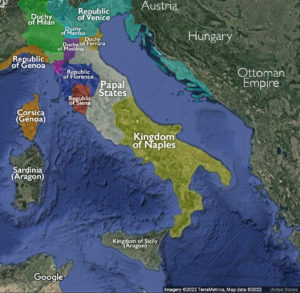
Cosmè Tura, Virgin and Child with Musician Angels, central panel of the Roverella Altarpiece, 1470s, oil and tempera on panel, 239 x 101.6 cm (National Gallery)
The central panel of what was once an enormous altarpiece, now in London’s National Gallery, shows a massively scaled Virgin Mary seated on a fantastical marble throne with the Christ child asleep in her lap. Painted by the Ferrarese artist Cosmè Tura in the 1470s, this painting was once part of a polyptych, originally over four meters in height.
Like many polyptychs from the renaissance, today this work is fragmented, its panels dispersed to multiple museums and the church it was created for no longer extant. Centuries of disasters, both natural (earthquakes, fire) and manmade (war, revolution), as well as changing visual tastes, mean that works from the early modern era seldom remain intact. Even in its fractured state, however, Tura’s altarpiece is spectacular in its monumental glamor. Above the seated Virgin and Child is a triumphal arch with a coffered barrel vault, a traditional symbol of victory borrowed from the ancient Romans. The Virgin wears a crown as the Queen of Heaven and her spectacular throne envelopes her, as though she is a statue in a rounded niche.
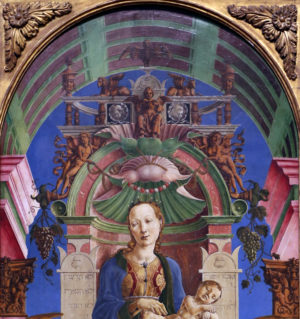
Cosmè Tura, Virgin and Child with Musician Angels (detail), central panel of the Roverella Altarpiece, 1470s, oil and tempera on panel, 239 x 101.6 cm (National Gallery)
The Queen of Heaven enthroned
Above the Virgin’s head is an oversized and hyper-stylized scallop shell from which hangs a strand of pearl and coral beads, alluding to the Virgin’s purity (white) and Christ’s Passion (red). Cherubs, painted to look like gilded carvings and standing on golden cornucopias overflowing with greenery, seem to hold up the shell with delicate ribbons.
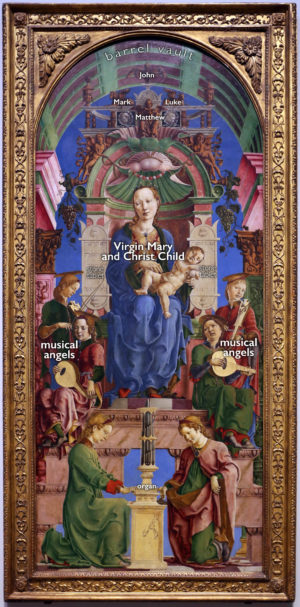
Cosmè Tura, Virgin and Child with Musician Angels, central panel of the Roverella Altarpiece, 1470s, oil and tempera on panel, 239 x 101.6 cm (National Gallery)
At the upper most portion of the throne, an architectural balcony is adorned with symbols of the four writers of the Gospels (the four Evangelists) presented as golden statues: an eagle (John), a winged lion (Mark), a winged man reading (Matthew), and a winged bull (Luke). As subjects, the Virgin and Child enthroned under a scallop shell (symbolizing divine conception) and surrounded by angels and symbols of the Gospels, is rather standard iconography. What is unusual is Tura’s magnificent artifice.
Tura’s use of color is striking. The brilliant lapis lazuli blue of the Virgin’s cloak and the sky behind the throne stand out from the dominant colors of green and pink applied asymmetrically throughout. A green pier with a golden capital on the right is balanced by a pink pier on the left, while the pink and green of the angel’s cloaks alternates from side to side, creating a rhythmic undulation of color.
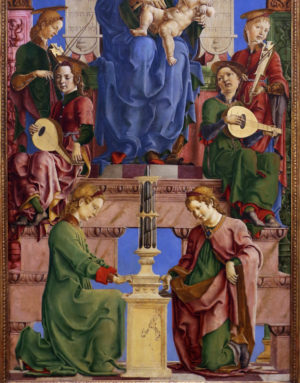
Cosmè Tura, Virgin and Child with Musician Angels (detail), central panel of the Roverella Altarpiece, 1470s, oil and tempera on panel, 239 x 101.6 cm (National Gallery)
This rhythm is not only visual—a sense of rhythmic hearing is aroused through the many music-making angels surrounding the Virgin and Child. On either side of the throne angels play stringed instruments, while in front of the throne, two angels play a small organ which once bore an inscription (no longer visible). In the Judeo-Christian tradition, music is a sacred art form and music-making themes—choirs of angels singing and playing instruments—are common in Christian art.
Celebrating House Roverella
The spectacular altarpiece that this panel was created for originally stood in the private chapel of the prominent Roverella family in the Church of San Giorgio in Ferrara. Part of an Olivetan Monastery just outside of Ferrara and the city’s original cathedral, San Giorgio was an important church while the Roverella were an important family: they dominated religious politics in the region and served in the papal court and in that of the Holy Roman Emperor. The altarpiece is generally believed to have been created to commemorate Lorenzo Roverella who was Bishop of Ferrara from 1460 until his death in 1474. The work stayed in its original position, in the prestigious site above the high altar in the chancel, until that section of the church was remodeled in the 1580s. There it remained until 1709 when the church and monastery was occupied by Prussian soldiers and the altarpiece partially destroyed by gunfire.
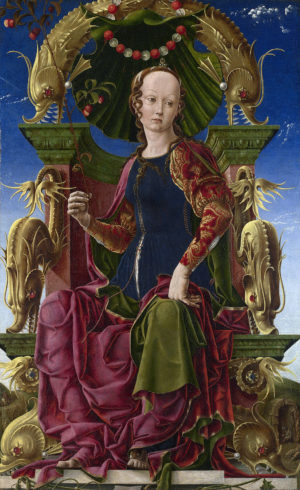
Created for the d’Este family’s hunting retreat of Belfiore, this image of the muse Calliope (a mythological figure embodying inspiration) was commissioned by Borso d’Este, ruler of Ferrara. Cosmè Tura, The Muse Calliope, 1455–60, oil and tempera on panel, 116.2 × 71.1 cm (National Gallery)
Tura’s approach to form is highly stylized, his profuse use of details and sinuous linework is often described as calligraphic. Like the swirls and curls of beautiful penmanship, Tura’s imagery suggests intellectual skill—the snaking lines of his figures’ draperies and the curious curves of their anatomy suggested sophistication to contemporary viewers; they saw this as an artful mediation of nature.
Cosmè Tura was closely associated with the ruling d’Este family of Ferrara for whom he created numerous artworks. This close association with the ruling family of the city made him a politically charged choice of artist for this project. The d’Este family, like others of their rank, appreciated an artist whose style suggested clever engagement with the visual world.
By patronizing Tura, the Roverella were embracing a stylistic language reflecting the “house style” of the d’Este family. We might read this as emulation, as the Roverella adopting the dominant style of their Ferrarese overlords in demonstration of allegiance. Alternatively, this may have been done in a spirit of competition, appropriating this visual language in service to their own family and thereby challenging d’Este cultural preeminence. Certainly, the sheer scale and grandiosity of the work coupled with Tura’s distinctive style would have made a powerful impression. [1]
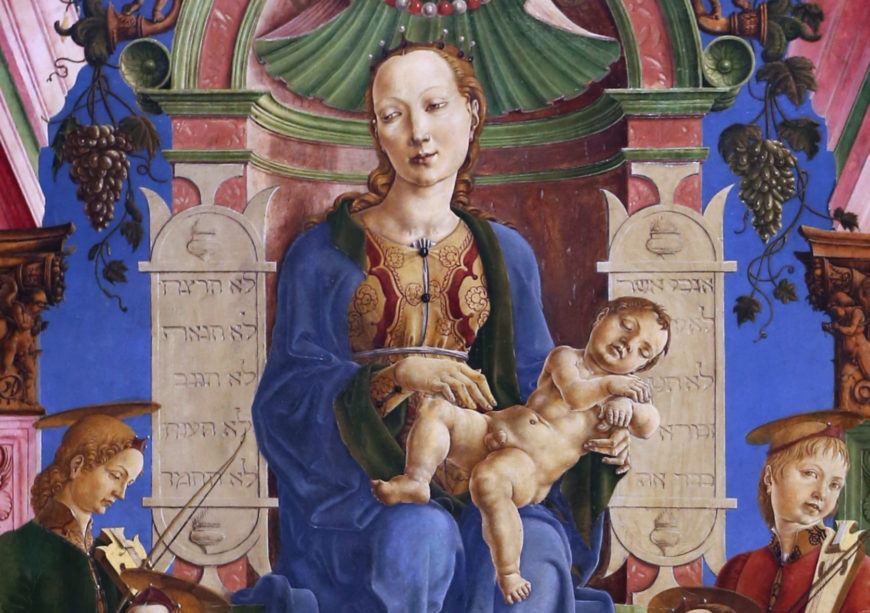
Cosmè Tura, Virgin and Child with Musician Angels (detail), central panel of the Roverella Altarpiece, 1470s, oil and tempera on panel, 239 x 101.6 cm (National Gallery)
Christian art triumphant
At either side of the Virgin’s throne, seemingly carved on to stone tablets, is the Hebrew text of the Ten Commandments. Notably, the sleeping Christ child’s head leans outward from the centrally placed throne, partially covering the second commandment presented in Hebrew. At this time, the second commandment was understood by Christians to mean the prohibition against creating images of the divine. [2] For Tura, who like other artists of his time, made his living largely through the creation of sacred art, this may have been a clever expression of the triumph of art as an expressive tool of the Church. From the early middle ages, it was Christian practice to assert the power of imagery to teach over the biblical prohibition of image-making.
We might also see this inclusion another way. Relations between Christians and Jews, who would have immediately been brought to viewers’ minds through the Hebrew text, were fraught throughout the early modern era. On the one hand, Christianity was understood to have descended from Judaism and the Hebrew Bible was adopted as the Christian’s so-called Old Testament. On the other hand, Christians saw themselves as transcending Judaism through the acceptance of Christ as their messiah or Savior and often blamed Jews for Christ’s death. The placement of Christ’s head in front of the Hebrew script may have expressed a pious Christian’s belief that their religion was a triumph over the older faith.

Cosmè Tura, Saints Paul and Maurelius with Cardinal Bartolomeo Roverella, right-hand panel, Roverella Altarpiece, 1470s, oil and tempera on panel, 154 x 76 cm (Galleria Colonna, Roma)
A gathering of saints
The triumphant exuberance of the central panel with its brilliant coloring, profusion of detail, and careful rendering of costly elements (marble, gold, precious instruments) was flanked by two side panels and crowned with a lunette (a semi-circular panel). The right-hand panel (now in the Palazzo Colonna, Rome) depicts Saints Paul and Maurelius, whose relics were found in the church of San Giorgio in 1419. The two saints stand behind a kneeling portrait of Cardinal Bartolomeo Roverella. Paul rests his hand protectively upon the Cardinal’s shoulder.
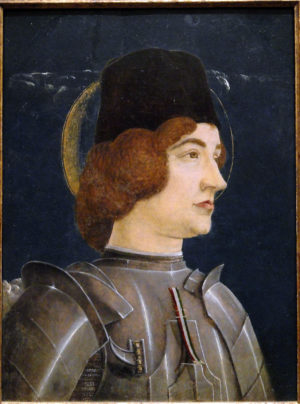
Cosmè Tura, Saint George, fragment of the left-hand panel, Roverella Altarpiece, 1470s, oil and tempera on panel, 38.74 cm x 29.05 cm (San Diego Museum of Art)
The left-hand panel survives only in a single fragment, an image of Saint George (now in the Museum of Fine Art, San Diego). It is possible that this panel originally depicted both Saint George and Saint Peter together with another kneeling monk (perhaps a portrait of Lorenzo Roverella). [3]
The two side panels were each topped by another panel, one showing Blessed Bernard Tolomei (founder of the Olivetan Order) and another showing Saint Benedict, although both of these have been lost. The predella—the panels originally at the lowest portion of the altarpiece—have also been lost, but are said to have featured scenes from the lives of Saints Bernard and Benedict. [4] Taken together, the whole ensemble would have conspicuously placed Roverella men in proximity to sacred figures dear to their local region and to Christianity as a whole. This public demonstration of model piety and divine protection was also intended to help secure favorable judgment for the Roveralla family at the end of time, earning them a place in heaven.
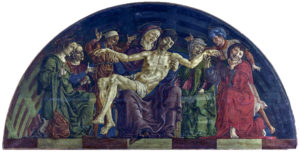
Cosmè Tura, Pietà, lunette from the Roverella Altarpiece, 1470s, oil and tempera on panel, 132 cm x 268 (Louvre)
The lunette (now in the Musée du Louvre, Paris), which crowned the entire work, depicts the lamentation: the dead Christ stretches across his mother’s lap, his extended arms recalling the cross of his crucifixion, while six mourners express their grief. The pairing of two images of Virgin and son on the same central axis—in the central panel below and in the lunette above—would have reminded viewers of the inevitability of Christ’s sacrifice. The vulnerable babe, asleep in his mother’s arms, was always destined to be the grown man whose corpse rests in that same mother’s lap. Similarly, the sweeping gestures and sorrowful facial expressions of Christ’s mourners above make a striking foil to the quiet joy of the figures below. The tragic gaze of Saint John, who looks directly outwards towards the viewer, reminds Christians of the great cost of their redemption.
Tura’s Roverella altarpiece, though known to us only in its current fragmentary state, speaks to the vibrancy and sophistication of late fifteenth-century Ferrarese art. Through calligraphic lines and the expressive gestures and facial expressions of his figures’ bodies he created a striking and celebratory image, one that reflected the glory of God and thus shed light upon the Roverella.
Notes:
[1] Stephen J. Campbell, Cosmè Tura of Ferrara: Style, Politics, and the Renaissance City, 1450–1495 (Yale University Press, 1997), p. 101.
[2] Christians, Jews, and Muslims have long debated the second commandment and what it says about the prohibition of images.
[3] A description of the altarpiece written in 1706 by the Ferrarese cleric, Girolamo Baruffaldi, describes this panel as originally depicting both Saint George and Saint Peter together with another kneeling monk, identified by Baruffadli as a portrait of Lorenzo Roverella.
[4] There are possible predella panels in several museum collections, though they are heavily contested. Using dendochronology, these works do not seem to correctly date to the same time period as the other panels.
Additional resources
Stephen J. Campbell, Cosmè Tura of Ferrara: Style, Politics, and the Renaissance City, 1450–1495. (Yale University Press, 1997).
Joseph Manca, Cosmè Tura: The Life and Art of a Painter in Estense Ferrara (Oxford: Clarendon Press, 2000).

